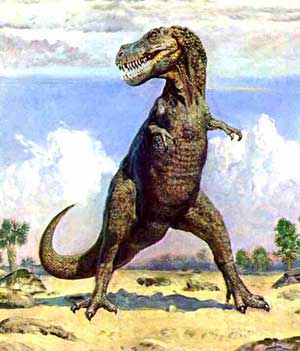Tyrant dinosaur: Sensitive animals
Tyrannosaurus (T.rex) not only has a particularly delicate sense of smell and hearing, but also has a habit of using prey-locating eyes and recognizes similar patterns to current predatory birds. .
Tyrannosaurus was discovered and named 100 years ago.
Since then the dinosaurs have become more attractive to the scientific community because of the standard external dimensions - it can be as high as 12m and weigh 7 tons - and the skeleton has a small upper extremity and extremely large teeth.
With these two characteristics, some researchers believe that the animal is primarily a scavenger animal like vulture birds today.

Tyrant Dinosaurs ( Illustrations from foreign websites )
Recreate dinosaurs from fossils
The hypothesis is further reinforced by the fossilized tomography test of an individual T.rex named Sue which has extremely large olfactory onions to help the animal smell the corpses in the surrounding area.
The team of Francois Therrien, Royal Tyrell Museum of Paleontology at Drumheler, Alberta, Canada found a compartment in the front of the monstrous lizard skull like its distant relatives today are birds and crocodile, cavity that limits the development of the olfactory bulb "perhaps only by the size of a plum".
Tyrant lizard has very sensitive nose. The relative size of the olfactory bulb compared to the two hemispheres is still larger than that of the other 7 dinosaurs, some of which have evolved similarly.
Lawrence Witmerr and Ryan Ridgely, Ohio Department of Bone Medicine at Athens, USA, also used computerized tomography to study the inner ear. The relative length of cochlea versus skull shows that the T.rex dinosaur has a higher hearing than other carnivorous dinosaurs.
The eyes are wide and wide
The structure of the inner ear can provide indicators of posture and balance of the animal has disappeared.

T-Rex through drawings of foreign experts
The length of the semi-circular tubes, helps the brain to know the orientation of the body and how to move in tyrant lizards with incredible development. According to Witmerr: The long tubes in the cochlea help the dinosaurs hold their head and eyes to correct the prey.
In current animals, the orientation of the side to the skull is attached to the head position when held high. The tyrant lizard holds his head posture down from 5 -10 degrees. For animals with a long, slightly bowed muzzle, it helps them see better than the animal facing.
An American researcher at the University of Oregon, Kent Stevens, also came to a similar conclusion about the vision of a tyrant lizard and placed it at the top of the table.
He evaluated the sight of the tyrant lizard and the other 6 predatory dinosaurs by restoring the animal's head to a sculptural experiment. By placing a plate in front of the animal's head and pointing the laser beam to the pupil of dinosaur eyes, he painted the animal's market.
The tyrant lizard has very wide eyes vision.
When it bends down to 10 degrees, it will optimize the market with the perception of the outside floating like the bird's outer view. According to Kent Stevens, with a keen sense of buoyancy, sound and taste, tyrant lizards deserve to be a typical predator.
According to James Hopson, of the University of Chicago, even if the hypothetical lizard is a type of corpse that is still endorsed by many people, it can be assumed that the lizard lizard also eats live bait.
- What effect does the legendary T-rex dinosaur's arm have?
- Can you survive a T-Rex by standing still?
- Discover new tyrant dinosaurs
- The T-Rex tyrant dinosaur has a homophobic behavior
- Decode secret million years of the most giant monster on Earth
- Hey, I am the T-Rex tyrant of Jurassic World and you are all wrong about me!
- Tyrant dinosaurs are granted Dutch passports
- Discover super big tyrant dinosaurs
- Detecting tyrannical dinosaurs with beautiful feathers
- T-rex tyrant dinosaurs also know 'love' - the shocking study of scientists
- Find relatives of tyrant dinosaurs
- Scientists recreate dinosaur embryos from chicken DNA
 Discovered an ancient centipede fossil 99 million years old
Discovered an ancient centipede fossil 99 million years old Discovered bat-like dinosaurs in China
Discovered bat-like dinosaurs in China Discovered a 200-year-old bronze cannon of the coast
Discovered a 200-year-old bronze cannon of the coast Discover 305 million-year-old spider fossils
Discover 305 million-year-old spider fossils